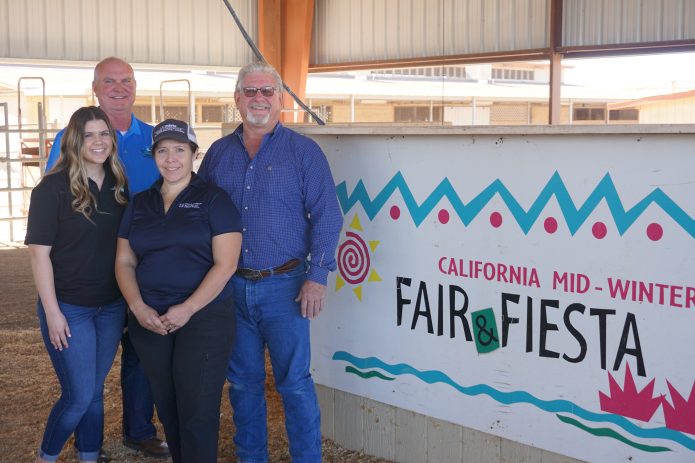
Pictured are (back row, left to right) Alan Phillips, Chief Executive Officer of the Imperial Valley Expo and the California Mid-Winter Fair & Fiesta, and Bo Shropshire, a member of the fair board, and (front row, left to right) Addyson Rubin, a local 4-H Club Ambassador, and Shanna Abatti, 4-H Club Program Director for Imperial County under the University of California Cooperative Extension. The four are pictured in one of the arenas at the fairgrounds used as part of the fair’s large animal auction. The large and small animal auctions are part of the fair’s history and highlight the hard work of area youth and the great support shown by the community.
Since Addyson Rubin was 9-years-old, this time of year has been special to her. It’s fair time, and for Addyson that has meant raising lambs to show and auction during the Imperial Valley’s California Mid-Winter Fair & Fiesta.
Now a high school senior, Addyson—a longtime member of the Verde 4-H Club in Holtville—has grown into a leader, traveling the state as a 4-H Ambassador for Imperial County, further developing skills that will help her as she prepares for college.
She points to her years in 4-H and her raising animals for the fair as core reasons she is ready for the challenges ahead.
Addyson is one of thousands of Imperial Valley youth participating in local 4-H and Future Farmers of America programs (FFA), both educational-based organizations that foster leadership among young people. FFA focuses on the many career pathways available through an agricultural education and is offered through local high schools. The 4-H Clubs, organized under University of California Cooperative Extension programs, gives young people a chance to participate in agricultural projects, plus other hands-on activities, like robotics, rocketry, and photography.
Addyson and more than a thousand other youth from the organizations participate every year in the animal showmanship competition and auction at the fair.
“You learn so much every year,” she said. “It’s a challenge every year.”
This year’s fair—the 110th year of the Mid-Winter Fair & Fiesta—kicks off March 2, and over its ten-day run, well over 100,000 people will attend for the rides, games, entertainment, and food.
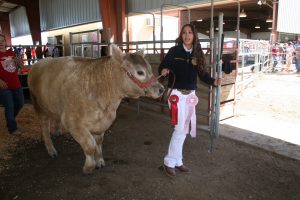
In this photograph from last year’s fair, a Future Farmers of America participant leads her steer through the arena at the California Mid-Winter Fair & Fiesta. Photo from IV Expo.
But not far from the carnival rides are the barns and arenas where youth in the familiar white and green 4-H uniforms and blue and white FFA uniforms will be hard at work showcasing the animals they have cared for and raised in the months leading up to the fair.
The livestock aspect of the fair unites the Imperial Valley like few other events, bringing together young people with guidance from their 4-H and FFA leaders, their parents, and the local business and agricultural communities to celebrate a tradition generations old of supporting youth and teaching them life lessons and leadership skills.
Last year’s animal auction raised nearly $1.8 million. Much of that money goes back to the youth, not only covering the expenses of raising an animal, but very often it becomes seed money for their college education.
Bo Shropshire, a member of the fair board assigned to the livestock committee, said the Imperial Valley community is unique in how much it supports the youth who raise animals. He said the local fair is one of two in the state (the Kern County fair is the second) with highest dollar figures coming from the auction.
“There are people here who will spend a lot of money to support our kids,” he said. “There are a lot of people here who understand this program and how much effort these kids put in to raising these animals.”
Shropshire himself grew up around fairs and raised animals as part of a 4-H program led by his father.
“You didn’t come to the dinner table until your animals had been fed,” he said. “You didn’t have breakfast until your animals had their breakfast.”
For the youth in the 4-H and FFA programs, raising livestock is a daily activity that starts early in the morning, continues after school and into the evening. Over the course of their work, they learn what it takes to care for an animal and keep it healthy.
“It ensures the youth see how important it is that the animals be treated ethically and humanely, and that ethical treatment produces high quality meat,” said Shanna Abatti, the 4-H program representative in Imperial County under the University of California Cooperative Extension.
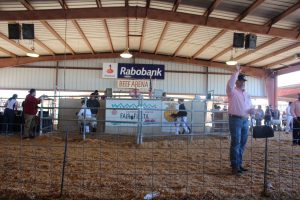
In this photo from last year’s fair, an auctioneer makes his way around the arena at the California Mid-Winter Fair & Fiesta. Photo from IV Expo.
The youth also build an understanding of economics as they balance costs associated with purchasing and feeding the animal. In many cases, the youth themselves open a special account at area banks, Sun Community and Community Valley Bank, and through a U.S. Department of Agriculture loan program, where they have to monitor costs and meet their loan payments.
“It gives them a chance to learn responsibility and accountability,” Shropshire said.
Abatti added, “They are getting to make real-life decisions.”
After months with their animals, the youth gather for a busy week of early mornings and late nights at the fair.
Their animals are divided into large and small categories with individual divisions for each kind of animal. Large animals range from the steer and calves, to swine, sheep and goats, and even horses. Small animals include chickens, rabbits, cavies, and winged wildlife.
During the first weekend, the youth and their animals participate in the market competition, which determines which animals will qualify for the auction held during the second weekend. The participants are vying for a gold ribbon, which states their animals are ready for market and thus ready for auction. But they are also competing for the distinction of earning champion or grand champion awards in market, and the highest honors—supreme champions.
The second weekend brings the auction. Those animals that received a gold ribbon are auctioned in the arenas. Those that did not are sold from the barns, but Shropshire said the community supports all the youth. Last year, nearly 800 animals took part in the auction.
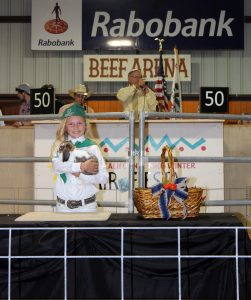
In this photo from last year’s fair, a young member of a local 4-H Club shows off the rabbit she has raised. Photo from IV Expo.
Abatti, who grew up in the Imperial Valley, participated every year in showing animals and benefitted from that community support. She said that experience, plus growing up in a family that works in agriculture, led her to pursue a degree from California State University, Fresno in agriculture communication, and she brought her knowledge of agriculture back to the Valley.
Now as the director overseeing 4-H in Imperial County, she makes sure local youth have the same positive experiences she did. She oversees a program with 8,000 kids participating throughout the county and some 17 4-H Clubs.
As part of the 4-H program, the youth can choose from many different hands-on projects, besides agriculture and raising animals, including robotics, photography, rocketry, electrical work, foods and nutrition, and their projects are also displayed in the science building at the fair. Last year, some 3,000 projects were displayed in the science building from communities throughout the Valley.
“The 4-H program is just awesome for kids,” Abatti said. “There are so many ways they can get involved. Raising an animal is just one facet.”
For Addyson, there was never a question whether she would join 4-H, and she knew she wanted to raise animals. She said though it takes a great deal of time, she has enjoyed it every year.
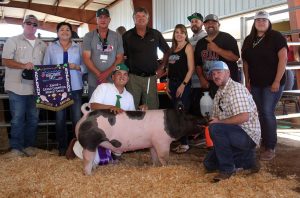
In this photo from last year’s fair, a local 4-H Club participant is pictured with his award winning swine, his family and community supporters.
“This is something you do six days a week for at least two hours a day,” she said. “I know I have to be with my lamb, but I don’t do it just because I have to. I do it because I love it, and I have learned so much from the community coming together to support us.”
She also credits her parents for the support they’ve given her, waking up early to get her to the fair and staying late with her. They made sure she had everything she needed to succeed.
“Their support has been massive,” she said.
But her time raising animals is almost over as she prepares for her next journey—university.
She is now looking forward to taking what she has learned and going on to university to study for a degree in political science with a focus on agriculture and water. And when she finishes school, she wants to return to the Valley to serve the community.
Shropshire said to see young people taking the leadership skills they learn from raising animals and being involved in organizations like 4-H and FFA, then going away to college, and returning home to better their community is an important outcome.
“A lot of these kids. They are going to get involved in their community afterwards, they are going to give back, they are going to be part of service clubs and be charitable,” he said. “That is what gives me a good feeling.”
